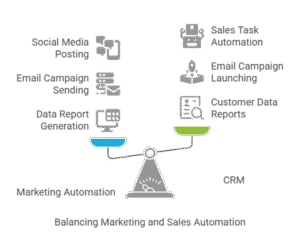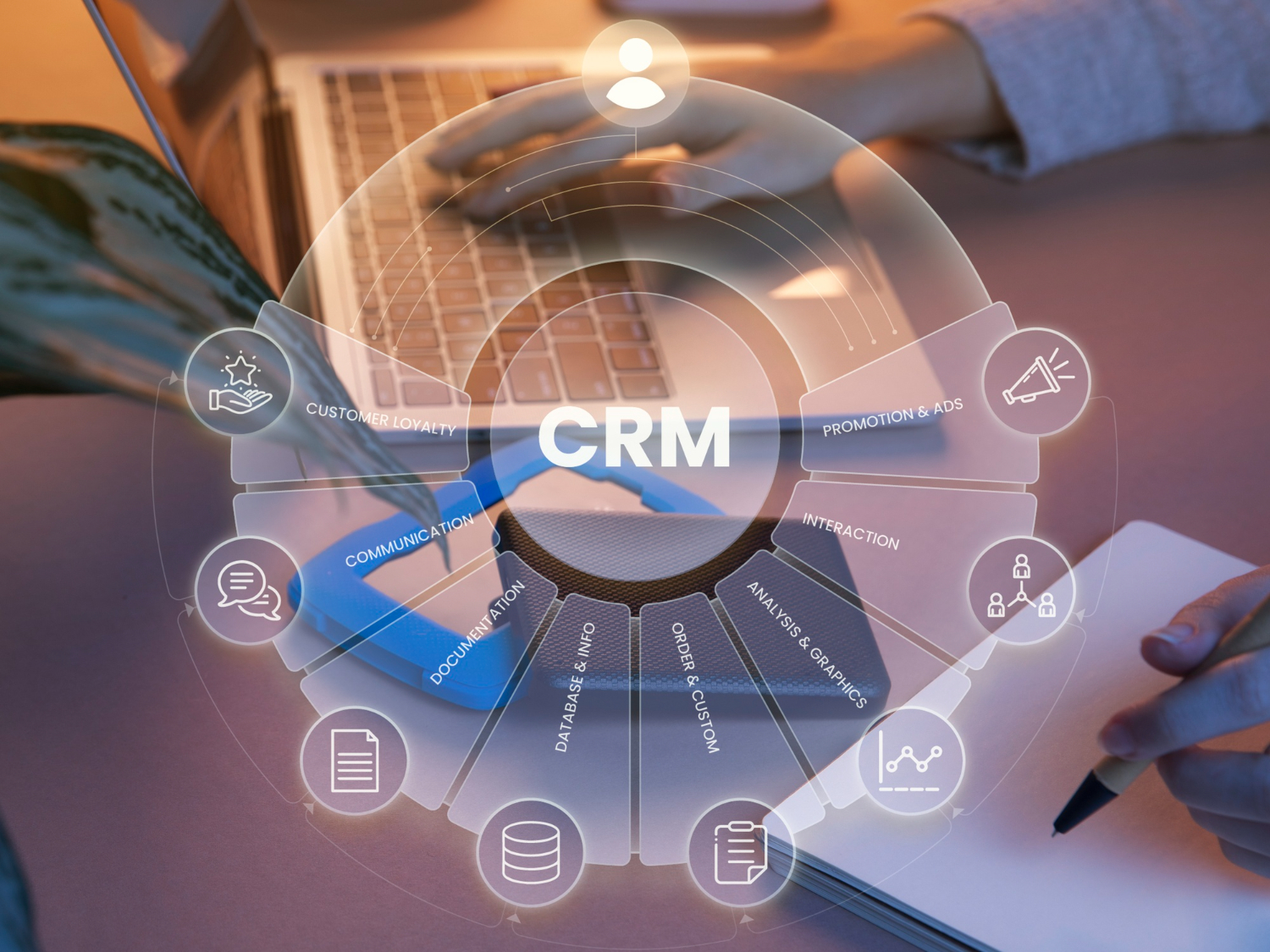Converting prospects into loyal customers is a hierarchical process, mostly relying on the efforts and input of cross-functional teams. CRM and marketing automation platforms remove the guesswork and tedious manual tasks, like chasing down leads, and can set you up for a powerful business impact by turning more prospects into qualified leads.
Though somewhat similar, each plays an essential role in supporting your business goals.
Read on to learn how your small business can reap the maximum benefits of CRM marketing automation software when you integrate these two significant soldiers.
Understanding CRM (Customer Relationship Management)
A CRM (Customer Relationship Management) software handles the entire sales funnel, from email marketing to customer service. It organises detailed customer profiles like purchase records, notes and interaction history, and deals with contact and sales management. CRM also takes care of all the nitty-gritties associated with customer support and agent productivity. A CRM is responsible for maintaining optimised workflows, ensuring premium customer satisfaction and saving you time and resources.
Its efficient software modules include customer segmentation, valued customer service, streamlining processes and shaping up sales activities, and managing and improving current deals. A CRM operates at an intuitive pace for active and potential customers. By pulling up information from social media accounts, email and website, and guiding each contact through the customer lifecycle, like alerting your agent of a customer’s piqued interest in your product or service.
Understanding Marketing Automation
Marketing automation software is a self-operating and efficient solution for sending out highly targeted messages across various platforms to your prospects. It smartly tracks customer behaviour and collects data from different sources, which influence and automate marketing actions that push the deals onward into the sales pipeline. 52% of the marketers prefer incorporating marketing automation features into other solutions to stimulate and achieve their marketing targets.
Similarly, marketing automation assists in promoting content without manual intervention, nullifying the chances of human error. This automation involves content distribution as per the prospect’s interests. This draws data from when leads carry out certain actions like visiting your website, filling out a form, or reading a blog, making it easier to frame your business strategy based on this specific information.
Marketing automation simplifies repetitive marketing tasks, like routing emails and WhatsApp messages, and launching e-commerce automation. With marketing automation technology, you can stack up data from other channels and apply it in your marketing campaigns.
At the end of the day, the core objective is to generate and nurture leads and move them as a sales-qualified lead through personalisation.
The Synergy Between CRM and Marketing Automation
To figure out how CRM and marketing automation team up, you must basically understand their differentiating factors. CRM is primarily used as a sales tool, and marketing automation is a lead generation and nurturing tool.
CRM and marketing automation platforms act as a data source that can score leads, optimise marketing campaigns, and manage customer segmentation with personalised targeting that will drive a high return on your investment (ROI).
Integrating the best CRM and marketing automation tools increases collaboration between marketing and sales teams, to win ideal insights into customer behaviour, build on lead quality, and free up resources, so that they can work more on the strategic and creative aspects of the business.
When CRM marketing automation software joins forces, it smooths out the entire customer journey, following the sales funnel, as they proceed from being a visitor to a loyal customer. This mutual synergy will equip your sales rep with the 360 view of a prospect’s interaction with your business. CRM fuels automation by feeding it customer data, so incorporating these two solutions is essential to making the most out of your automation drive.

How it Eases the Challenges of Separate Systems
The incorporation of these two systems helps you grasp the gaps in your marketing and sales approaches. It helps you detect why leads aren’t moving in the sales pipeline and why prospects are not closing.
By tying up the loose ends, with the best crm and marketing platforms, a coordinated approach, businesses can boost the performance of their sales and marketing team, which will accordingly make their customers satisfied with their product or services.
Here’s what happens when you use these together:
- Turn strangers into customers, not just leads – Build trust before sales jump in.
- Get real insights, not just data – Know exactly which efforts pay off.
- Prioritise the right leads – Stop chasing maybes.
- Create a frictionless buyer’s journey – From first visit to final sale.
- Arm sales with context – No more “Who is this person?
- Keep your brand voice consistent – No mixed signals in your nurture campaigns.
Smooth processes = happier teams + better conversions.
Let’s go through how two software features come together in a real-world application.
Example of Marketing Automation and CRM Working Together
A small business owner, Sarah, stumbles upon an ad for a project management tool while scrolling through LinkedIn. Intrigued, she clicks on the ad and lands on a blog post titled “5 Ways to Streamline Your Team’s Workflow.”
After reading, she finds the tips useful and decides to download a free checklist—”The Ultimate Guide to Productivity Hacks.” She fills out a form with her name, email, and company details. Instantly, the marketing automation tool adds her to a nurturing sequence, sending her personalised emails with more resources, case studies, and tips over the next few weeks.
As Sarah engages with these emails—opening some, clicking links, even attending a webinar—the system scores her as a Marketing-Qualified Lead (MQL). A few weeks later, she clicks a CTA to book a demo. Now, she’s flagged as a Sales-Qualified Lead (SQL).
Here’s where CRM software brings its thunder. The sales rep, Alex, pulls up Sarah’s profile in the CRM and sees everything—the blogs she read, the checklist she downloaded, even her LinkedIn profile. He notices she runs a creative agency and has shown interest in time-tracking features. Armed with this insight, Alex personalises the demo, focusing on how the tool helps agencies manage deadlines and client feedback efficiently.
By the end of the call, Sarah feels understood, not just pitched to. She signs up for a paid plan.
From first click to closed deal, marketing automation nurtured her, while CRM empowered sales with context. Together, they turned curiosity into conversion.
Benefits of Integrated CRM and Marketing Automation
Let’s go through some ways you can contribute to your business success with the combined efforts of marketing automation with your CRM.
Amplify Coordination between Marketing and Sales
The demand for solutions within cross-functional teams, like sales and marketing, is always a hot topic. It is also a domain where integration comes into play.
Every lead follows a different customer journey; their paths are somewhat like a maze, weaving through certain touchpoints. A prospect may not come from the source that you may expect, but sales and marketing need to fill in the cracks, connect the dots, and be ready to convert prospects into paying clients at any stage of the journey.
Integrating CRM and marketing automation clarifies these steps. Sales will comprehend when to reach out to the prospect, and marketing will foresee when their content is required.
For example, your CRM will transfer customers’ demographics to your marketing automation tool, which will ease out the workflow for your agents. Your marketing team can then apply this organised information to target campaigns and paid advertisements.
This well-coordinated check lets the teams know how far they have come in the process and what their actions should be in the future.
More Sales- Shortened Process
Without the CRM marketing automation tools working in union, it is time-consuming to source leads. With their integration, you can deliver the best to your active and future customers. You can easily follow up and check on customer activities and map out your plans based on this information.
This implies you can shoot marketing messages that benefit and appeal to your customers at the right moment. The optimal duration for the sales process will also quicken as the customer’s needs are timely manner. All of this implies a higher customer satisfaction level and sets you up for more upselling and cross-selling opportunities.
A modern automation solution helps you score customer activities. As a certain number of points are maxed out, sales get notified that a lead is warm and ready for conversion. Preferably, the sales team will probe into customer desires in the CRM software before making their first move.
Two-way Flow of Customer Data
With both software working in parallel, customer data flows consistently between the tools. This is an awesome feature because,
- No data leaks, no data blocks, since it flows smoothly from one tool to another
- Easily accessible communication history with each customer
Equipped to send automated messages to segmented groups drawn from the CRM. After marketing actions, the CRM data gets refuelled on how the customers responded to the targeted messages.
With the unified data management in action, salespersons don’t have to go to great lengths to source customer profile information, but rather are ready to sell, with the fusion of the two software working together.
Personalised Customer Communication
You can up your marketing game with personalised messaging. A well-established research shows that customers are more responsive to the messages that address their demands.
Statistics reveal that 87% of the customers expect marketers to be aware of their previous, current and future needs with their products and services. Before the unification of CRM and marketing automation, customer data was stored in different tools. When grouped, they are invincible, taking cues from customer behaviour and customising messages that click with them.
You can pluck out any customer data that you want to personalise it for, such as purchase history, company details, interests, desires and more. You can get a clear-cut picture of customer behaviour when you integrate systems with marketing automation. Armed with this set of information in a customer’s CRM profile, you can track customer activity such as website visits, form filling, and newsletter sign-ups.
Ideally, sales gets empowered with a well-planned strategic approach to tackle customer communication effectively. The marketing team acquires a concept map of which messages sit well with the customers, and which content the leads find more attractive and value-driven.
Implementation Considerations
How to get started
Let’s get down to the checklist you need to mark off to work with a synchronised integrated system.
Here is how you should get started:
Access to the Tech
Always invest in first-class software that already comes with an integration module. This way, you can consolidate it with the other tools and streamline your operations. This implies the efficient use of the solution, right when you need it.
Structure the Process
Get your marketing and sales team on board, and anticipate the full-scale customer journey. It can help you pinpoint the actions needed at certain stages of the customer lifecycle. Your key components to consider are: lead generation, sales outreach and automated employee integration to welcome customers.
Design Individualised Plans
You will use demographics to lay out personalised marketing messages. You can extract and organise different sets of customer data, like name, location, age, previous interaction with the products, through subscription forms, and then base your strategic marketing on these grounds.
Set Up Automation
Be sure to create automated workflows for multiple goals like lead nurturing, optimising customer relationships and support, along with retaining inactive customers.
Review and Optimise
When your automation workflows are assembled and launched, it is crucial to supervise their impact and fine-tune their performance with shifting demands. Improvise with various elements such as diversified content, changing subject lines, and sent timings to assess user response with the automation feature.
The Best CRM for Marketing Automation
CRM and marketing automation are the perfect duo for streamlined business success. Just as customer relationship management nurtures long-term client connections, marketing automation ensures targeted, efficient outreach to prospects. Whether you integrate both separately or use an all-in-one system, the synergy between these platforms amplifies your results. By automating routine tasks, you empower your team to focus on strategic goals, driving both satisfaction and business growth. The benefits are clear: increased efficiency, happier employees, and, most importantly, measurable results that align with your objectives.
Sharp AI marketing automation tools help streamline repetitive tasks such as follow-ups, email campaigns, and appointment reminders, increasing overall efficiency. By automating these processes, businesses can ensure timely and consistent communication with their customers. This approach frees up time to focus on building stronger customer relationships, ultimately leading to higher engagement and conversions.
Sharp AI automation solutions aim to enhance the customer experience while optimising marketing workflows. With these tools, businesses can maintain a continuous flow of communication, improving their marketing efforts and driving better results.
Explore Sharp AI here to see how it can enhance your automation strategy.
FAQs
1. What’s the difference between CRM and marketing automation?
A CRM (Customer Relationship Management) system manages customer data, interactions, and sales pipelines, helping businesses track leads and nurture relationships.
Marketing automation focuses on automating repetitive marketing tasks—like email campaigns, lead scoring, and behaviour-based triggers—to engage prospects efficiently.
While CRM organises customer information, marketing automation leverages that data to deliver personalised, timely marketing efforts. Together, they create a seamless customer journey
2. Can CRM work without marketing automation?
Yes, but it’s like having a phonebook without a dialer—you have the contacts but lack automated outreach. A CRM stores customer data, but without marketing automation:
- Follow-ups are manual (time-consuming).
- Personalisation is harder at scale.
- Lead nurturing is less efficient.
Marketing automation enhances CRM by turning data into actionable, automated campaigns, boosting engagement and conversions.
3. How do CRM and marketing automation improve lead nurturing?
- CRM tracks leads through the sales funnel.
- Marketing automation sends targeted content (emails, ads, reminders) based on lead behaviour (e.g., website visits, email clicks).
Example: A lead downloads an ebook (tracked in CRM). Marketing automation then sends a follow-up email with a related case study, moving them closer to a sale.
4. Why is integration between CRM and marketing automation important?
Integration ensures:
- Data accuracy (no silos between sales and marketing).
- Personalised campaigns (using CRM insights for segmentation).
- Efficient workflows (automated lead handoffs from marketing to sales).
Without integration, teams waste time on manual updates and miss opportunities for timely engagement.
5. How does combining CRM & marketing automation boost ROI?
- Higher conversions: Automated, behaviour-triggered emails improve engagement.
- Better lead scoring: CRM data helps prioritise high-intent leads.
- Time savings: Automation reduces repetitive tasks, letting teams focus on strategy.
Businesses using both see higher revenue growth (HubSpot reports up to 451% increase in qualified leads).
6. Which should I implement first: CRM or marketing automation?
Start with a CRM to centralise customer data. Once you have enough leads and need scalable engagement, add marketing automation.
Pro Tip: Choose platforms that integrate easily (e.g., HubSpot, Salesforce + Pardot, Zoho CRM + Zoho Marketing Automation).
7. What are the risks of not combining CRM and marketing automation?
- Disjointed customer experiences (e.g., sales calls repeating email content).
- Missed opportunities (leads falling through cracks).
- Inefficient teams (manual processes slow growth).
Integration aligns sales and marketing, creating a smooth, data-driven customer journey.
8. Can small businesses benefit from CRM and marketing automation?
Absolutely! Affordable tools (like HubSpot, ActiveCampaign, or Keap) help small businesses:
- Automate follow-ups.
- Track customer interactions.
- Scale without hiring more staff.
Result: Better customer relationships and higher sales with less effort.





